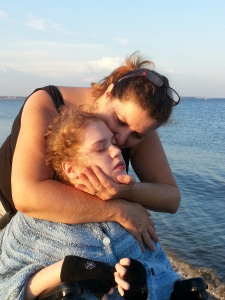A Promise
Chelsea is 18 years old today. It’s a milestone birthday that parents of special needs children face with mixed emotions. My heart is full with love and pride for the beautiful, emotive, tender yet determined young woman that Chelsea has become. But today I am also mourning. Mourning for a childhood never lived and forever lost.

When Chelsea was a toddler I made her a promise - that I would do everything in my power to heal her. With little science background, zero drug development knowledge and no fundraising experience I did not appreciate the enormity of my promise. Ignorance, at times, can be a blessing.
The Rett research landscape in the year Chelsea was diagnosed, 1998, was dismal. The disorder was practically unknown in medical and scientific circles, there was no known gene and therefore no diagnostic blood test, there were no animal models, and there was little research beyond trying to pinpoint the genetic cause.
My conviction that treatments and a cure for Rett were possible came from both visceral intuition and a mother’s love. Today that conviction is based on science.
But when will that cure come? Is it really “around the corner” as I so often read on facebook and other social media? I do not know the timeframe associated with “around the corner” (is it weeks, months, years?) but I am confident that a number of treatments will become available to our children in the coming years that will improve certain symptoms. The Potential Rett Syndrome Therapeutics chart on the RSRT website provides insight into the numerous interventions currently being pursued.
As parents we will take any improvement in our children’s symptoms that we can get. But what about the “like it never even happened” cure? (My all-time favorite catchphrase from the disaster restoration company, SERVPRO) For now we do not know whether the cure will be gene therapy, or protein replacement or activating the silent MECP2 (or the entire X chromosome) or a drug that modulates a modifier gene or perhaps a combination of some or all of these approaches. And we don’t know what a cure for someone like my daughter, who is now an adult, will look like. Will she be able to speak, to walk, to use her hands?
I do not focus on these questions because they are, for now, unanswerable. I concentrate only on the facts and these include:
- The reversal experiments originally done in Adrian Bird’s lab and repeated over and over again in many labs gives us solid proof-of-principle that dramatic reversal of symptoms should be possible. I have yet to hear one piece of scientific data that would dampen my optimism that a cure is possible.
- Scientists are making progress on many fronts including gene therapy.
- Rett researchers are collaborating and sharing information in real-time in a way that is unprecedented. Examples include the MECP2 Consortium, the Gene Therapy Consortium, and researchers focused on reactivating the silent MECP2.
- Technologies exist today that are enabling experiments that only a few years ago would be impossible.
- Rett has become a high-profile disorder in scientific circles.
- Biotech and big pharma, for the first time, are showing an interest in Rett Syndrome.
- Science is not linear. We do not know what might lie around the corner that can dramatically accelerate the development of a cure.
Those of you who know me will know that I am aggressive when it comes to pushing the science forward but I am conservative in how research progress is relayed to families. I prefer facts over hype.
Could a cure for Rett be around the corner? The answer to that question will come when we have a clearer picture of what form that cure will take. I can assure you that I will not rest until we accomplish that.
Love alone cannot cure Rett but love and research will. It’s been 16 years and I am more than ready to deliver on my promise.


